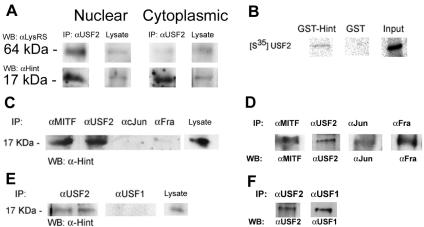FIG. 1.
(A) Coimmunoprecipitation of USF2 with LysRS and Hint. RBL cells were subjected to nuclear and cytoplasmic extraction from 5 × 106 cells, and the lysates were incubated with anti-USF2 antibody. The resolved immunocomplexes and lysate input control (5%) were analyzed by Western blotting with anti-LysRS and anti-Hint antibodies. One representative of three is shown. (B) A pulldown assay of [35S]methionine-labeled USF2 by GST-Hint fusion protein. The GST-Hint protein bound to glutathione-Sepharose beads was incubated with [35S]methionine-labeled USF2 overnight at 4°C. One representative result of three is shown. (C) Coimmunoprecipitation of Hint with USF2, MITF, cJun, and Fra. RBL cell lysates were subjected to immunoprecipitation with anti-USF2, anti-MITF, anti-cJun, and anti-Fra antibodies. The resolved immunocomplexes and lysate input control (5%) were analyzed by Western blotting analysis with anti-Hint antibody. One representative result of three is shown. (D) Precipitation efficiency of anti-MITF, anti-USF2, anti-cJun, and anti-Fra antibodies. RBL lysates were immunoprecipitated with the antibodies indicated on the top, and the resolved immunocomplexes were subjected to Western blotting with the antibodies indicated on the bottom. (E) Coimmunoprecipitation of Hint with USF2 and USF1. RBL cell lysates were subjected to immunoprecipitation with anti-USF1 and anti-USF2 antibodies. The resolved immunocomplexes and lysate input control (5%) were analyzed by Western blotting analysis with anti-Hint antibody and are shown in duplicate. One representative result of three is shown. (F) Precipitation efficiency of anti-USF1 and anti-USF2 antibodies.

